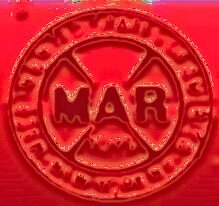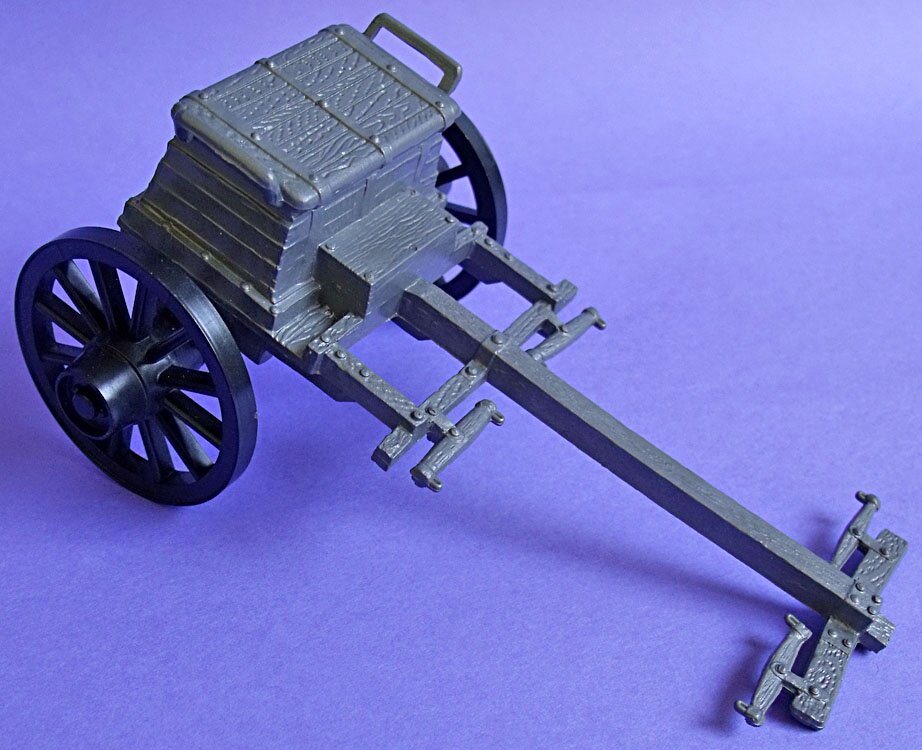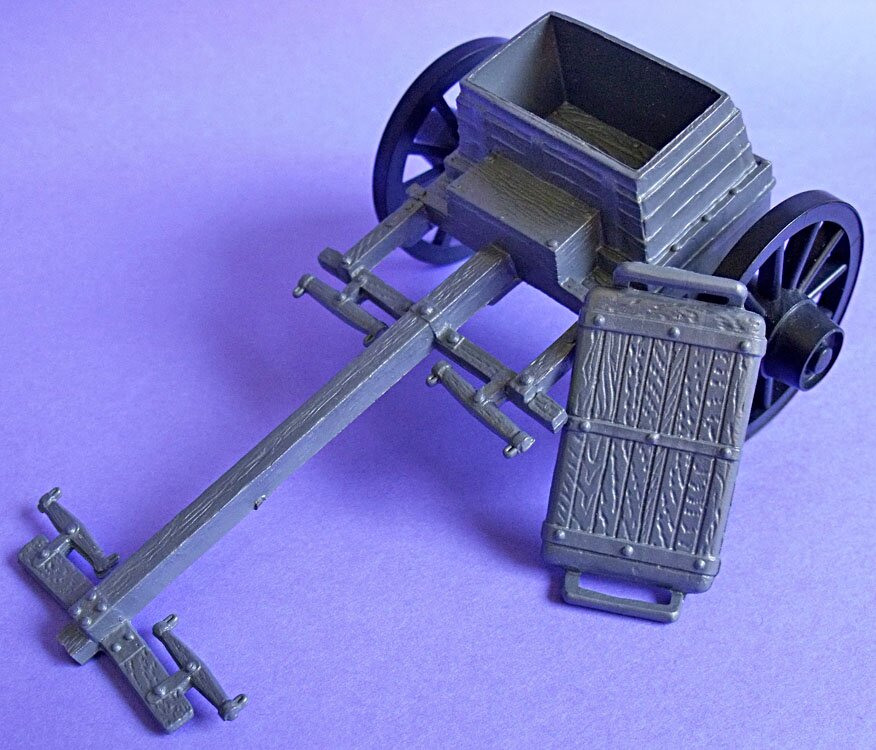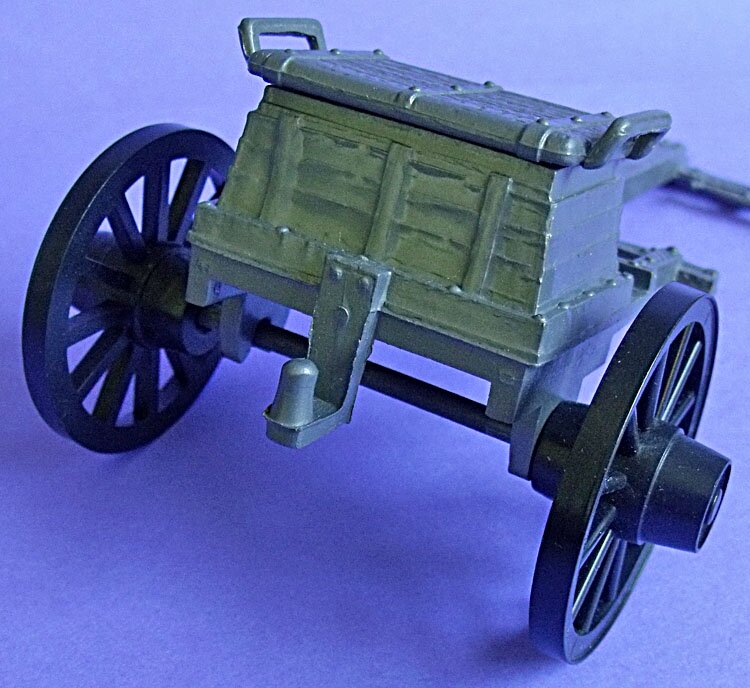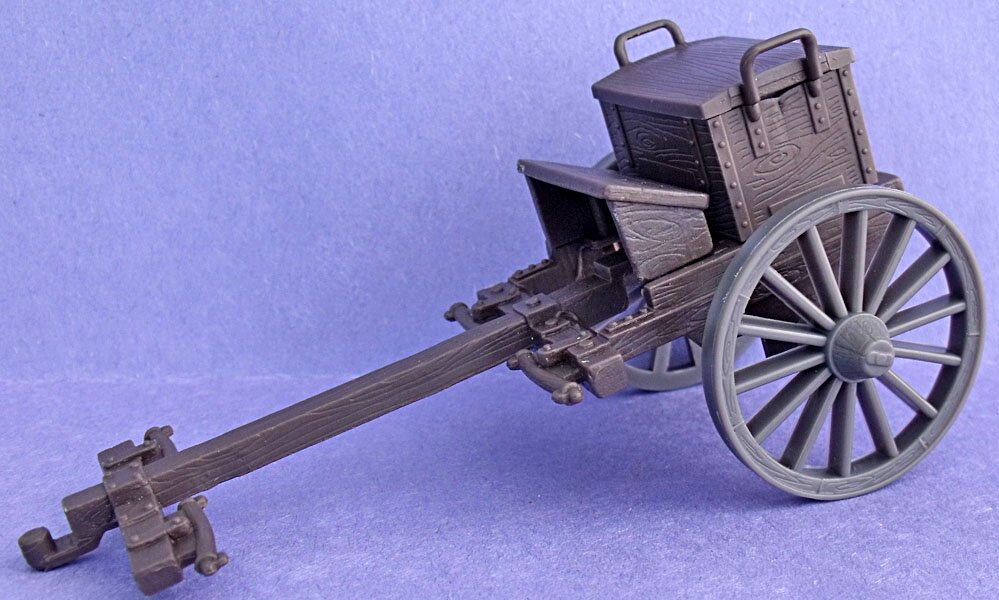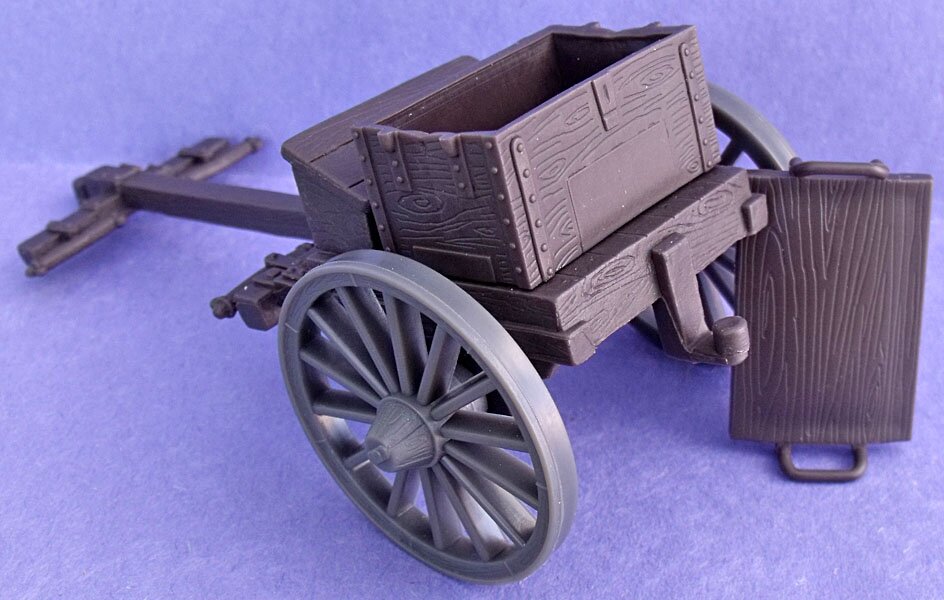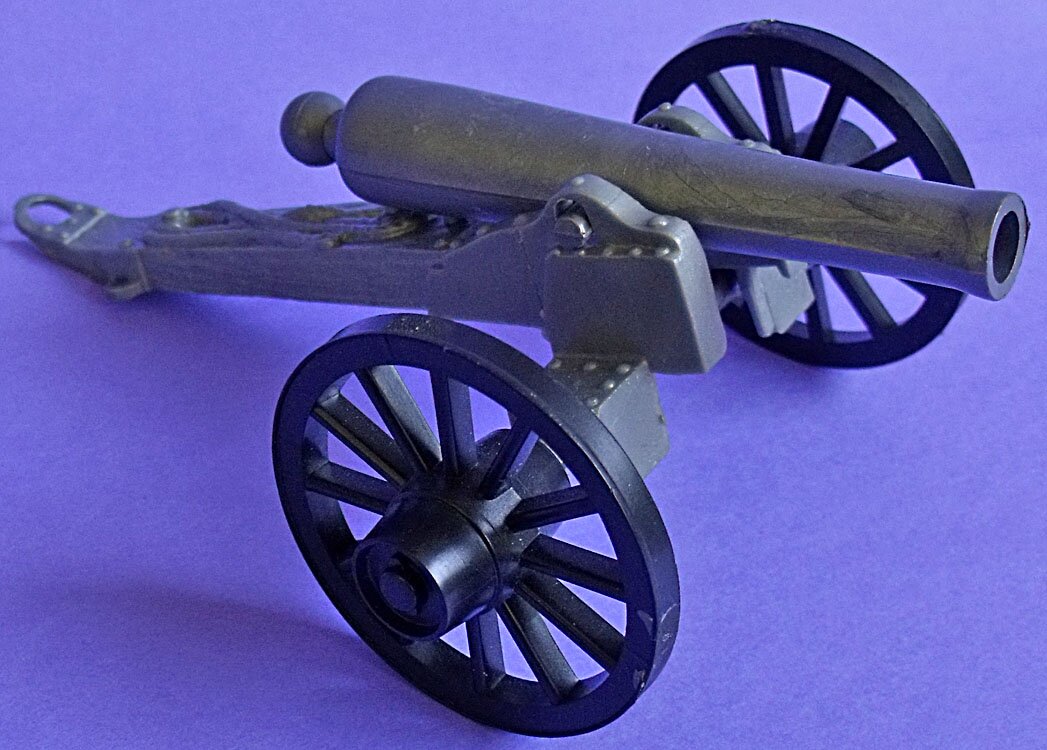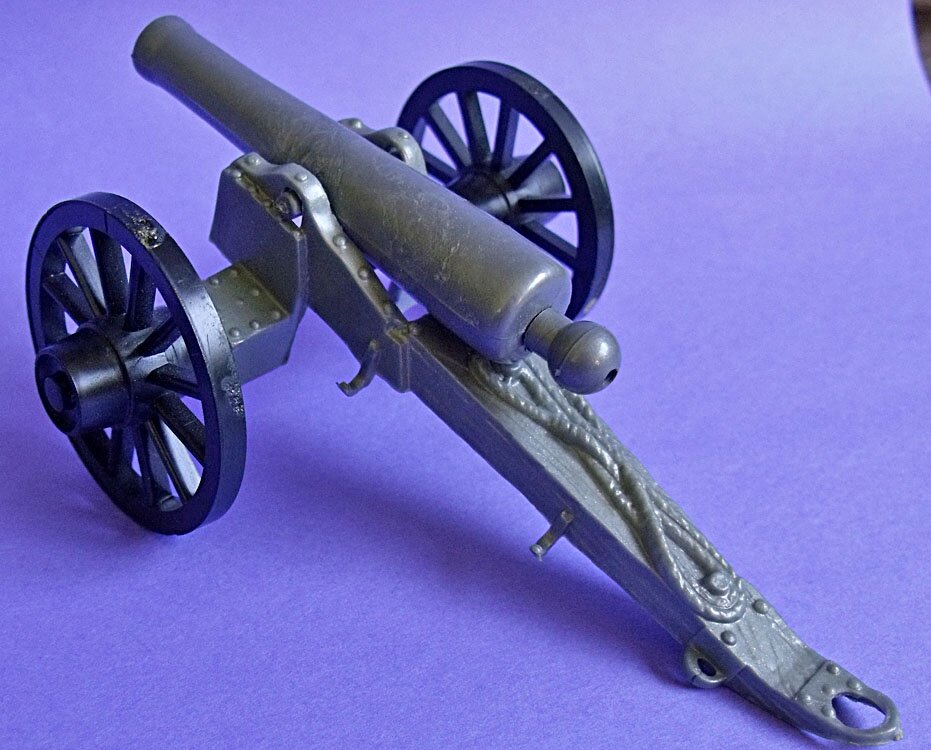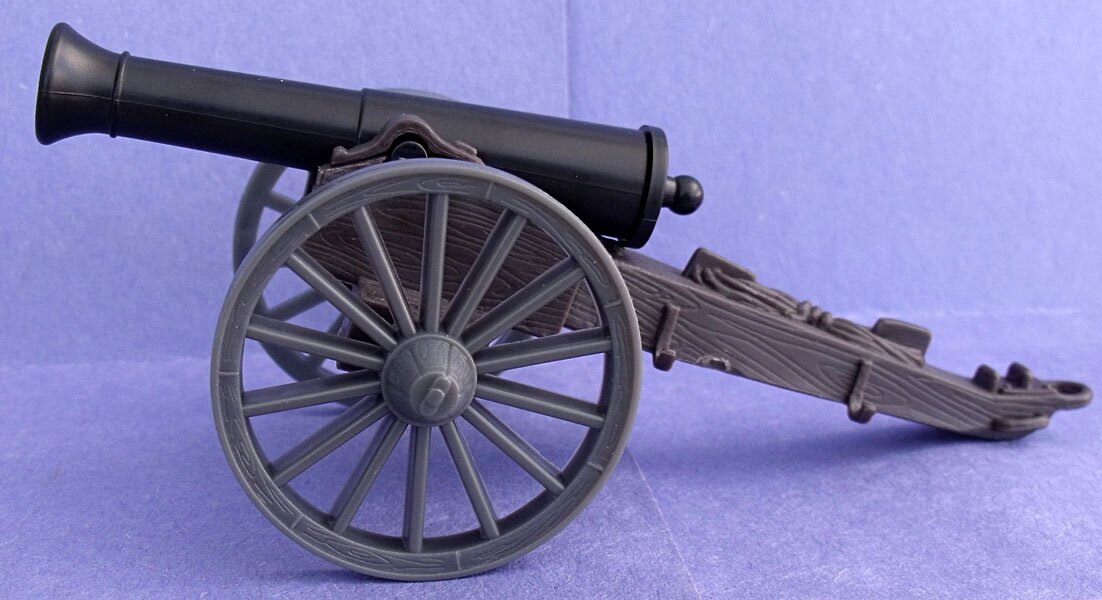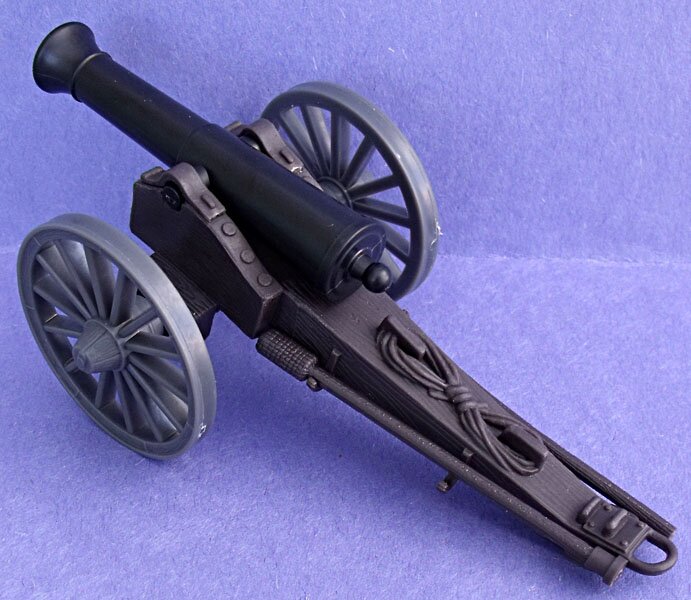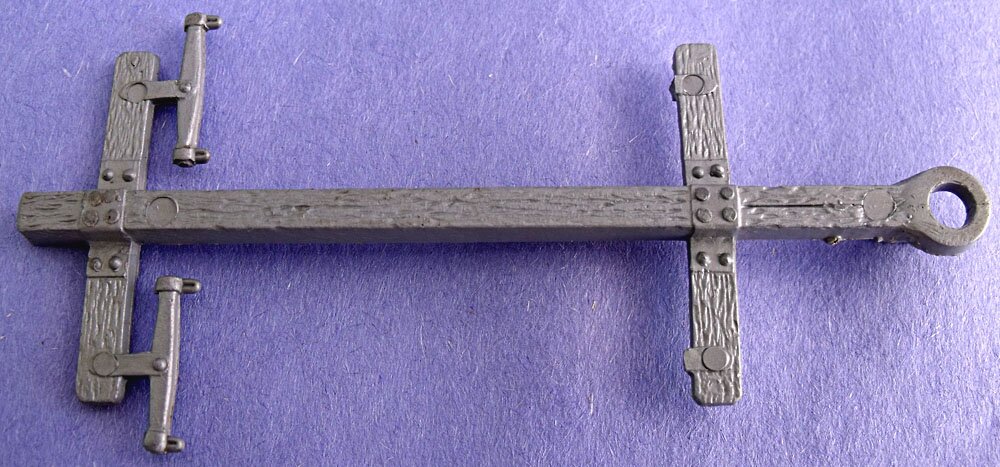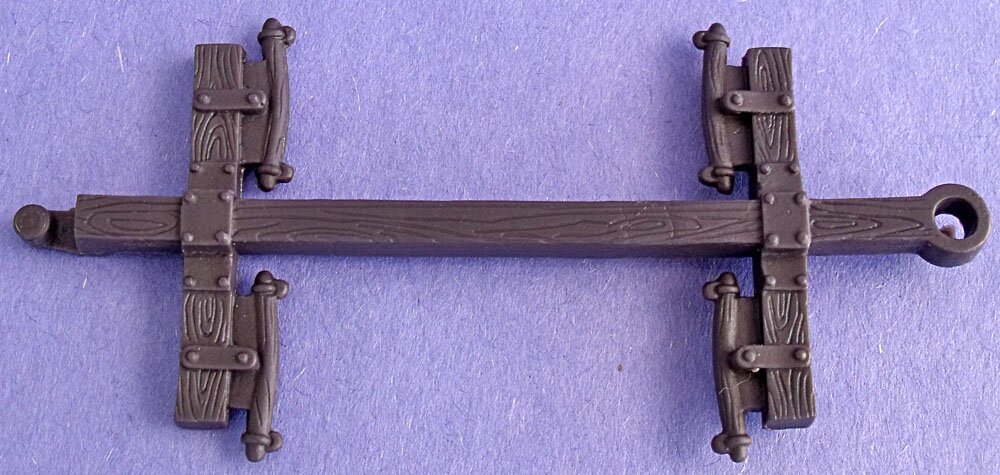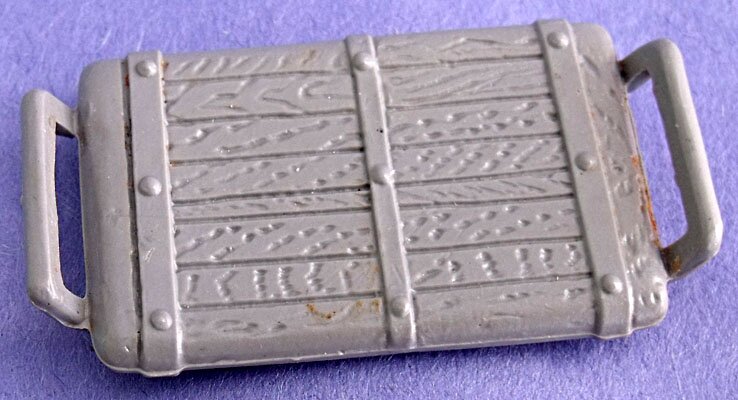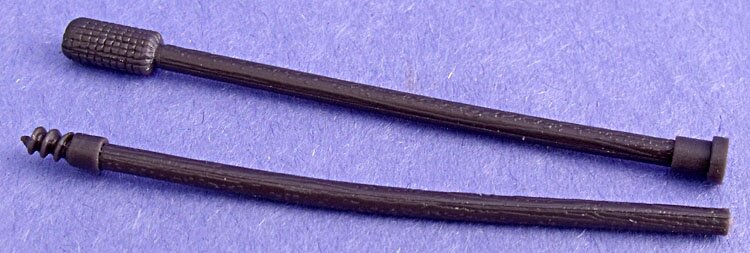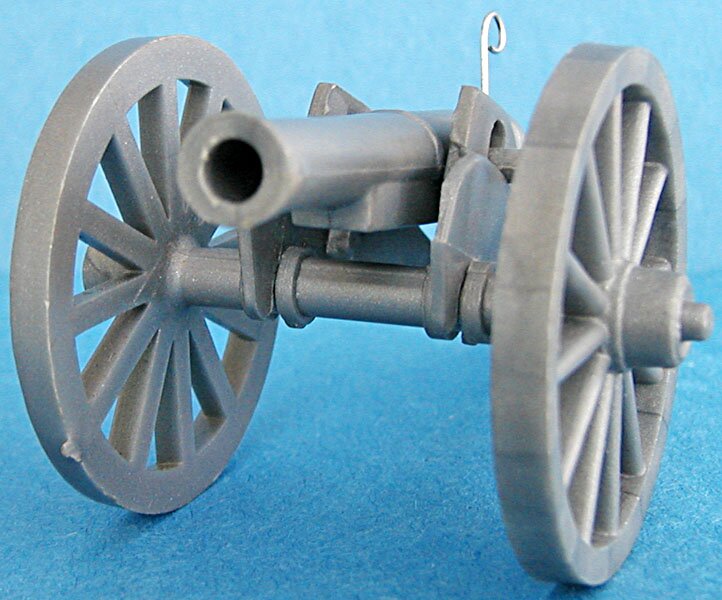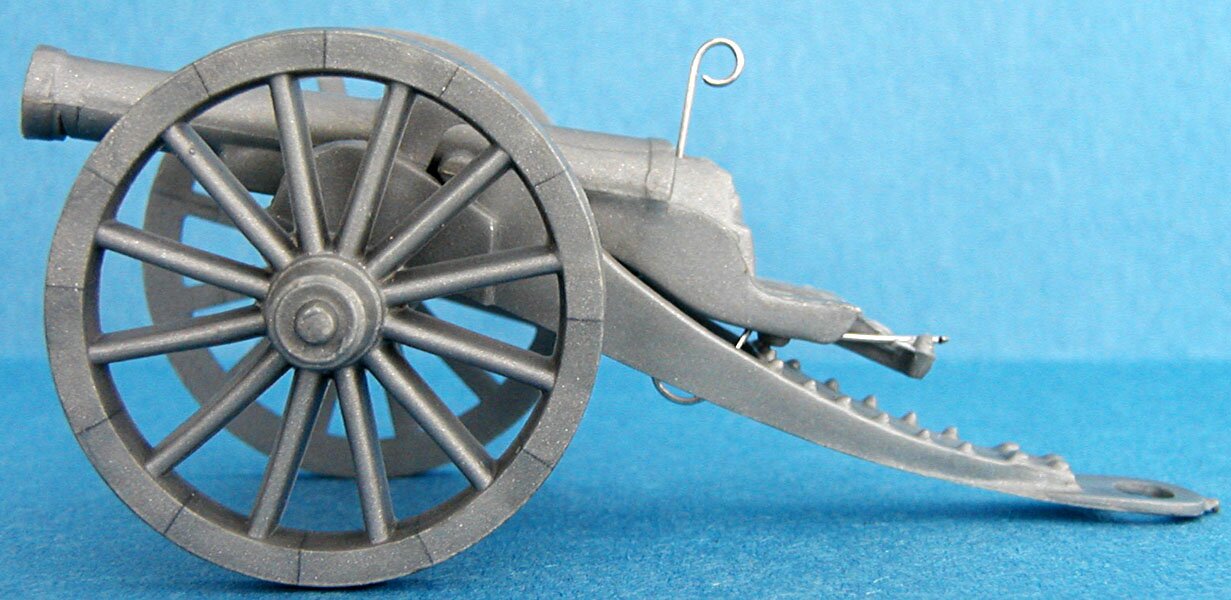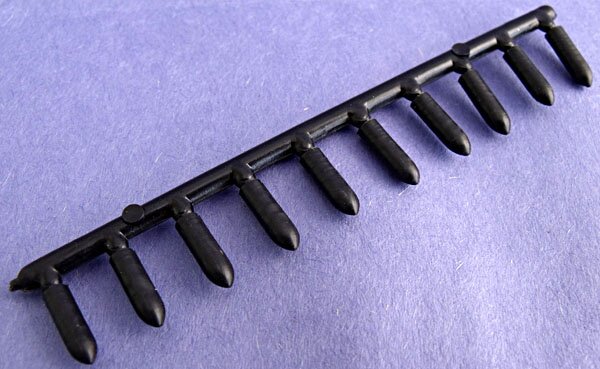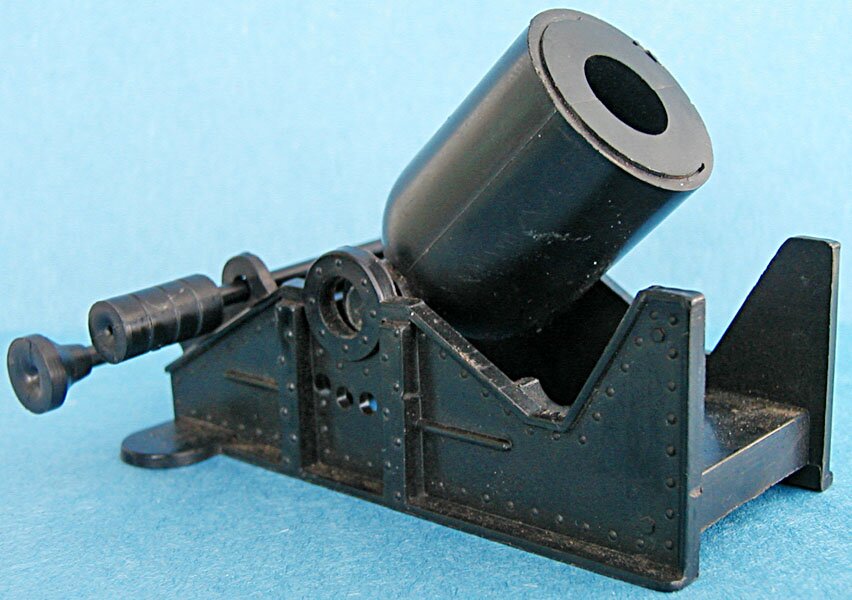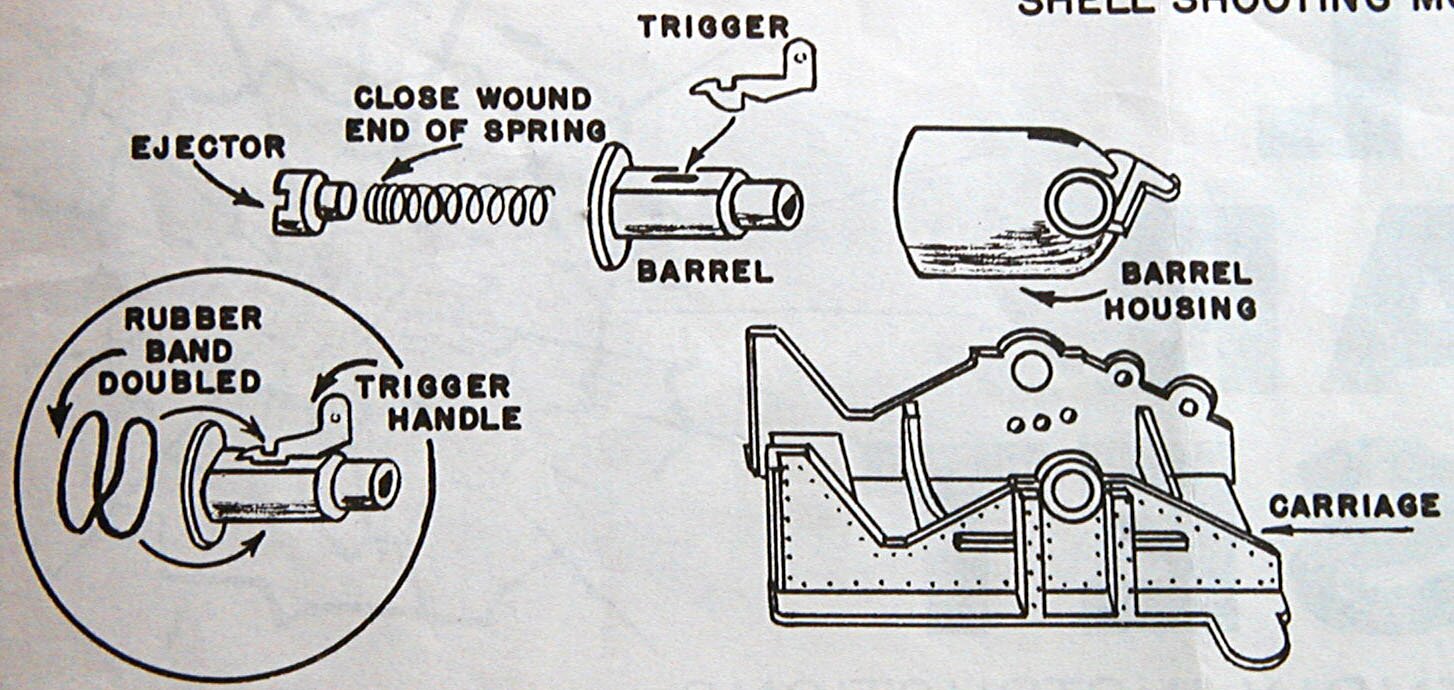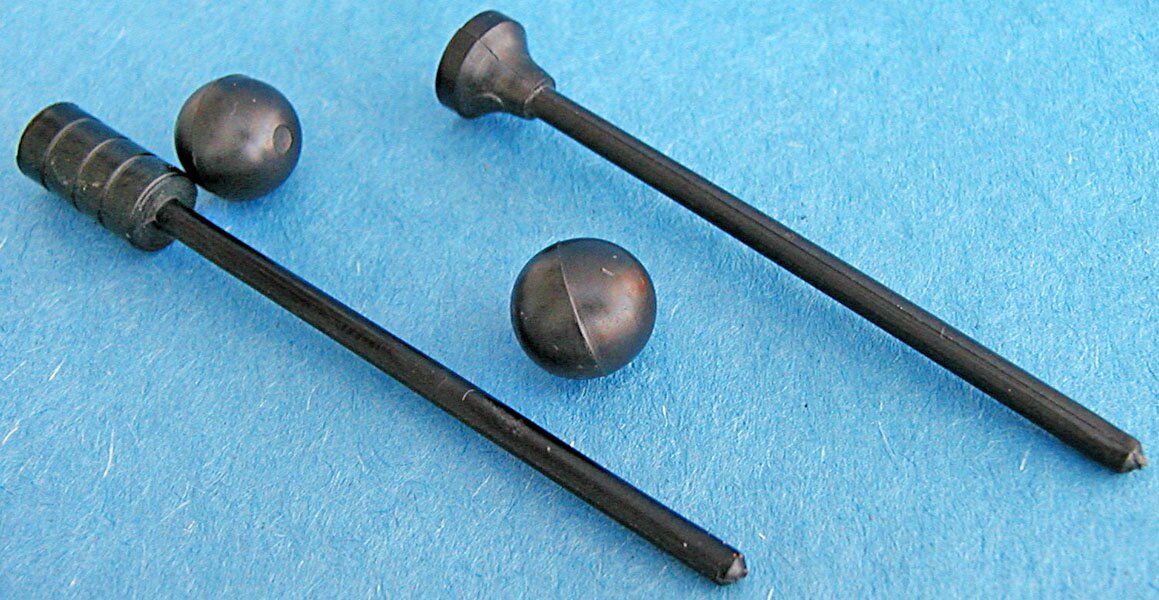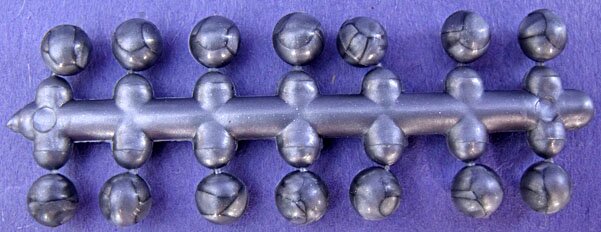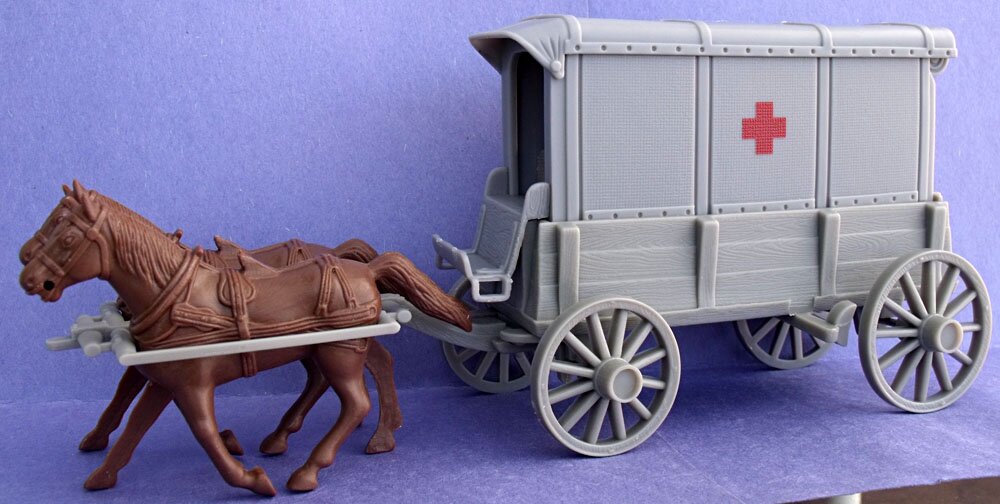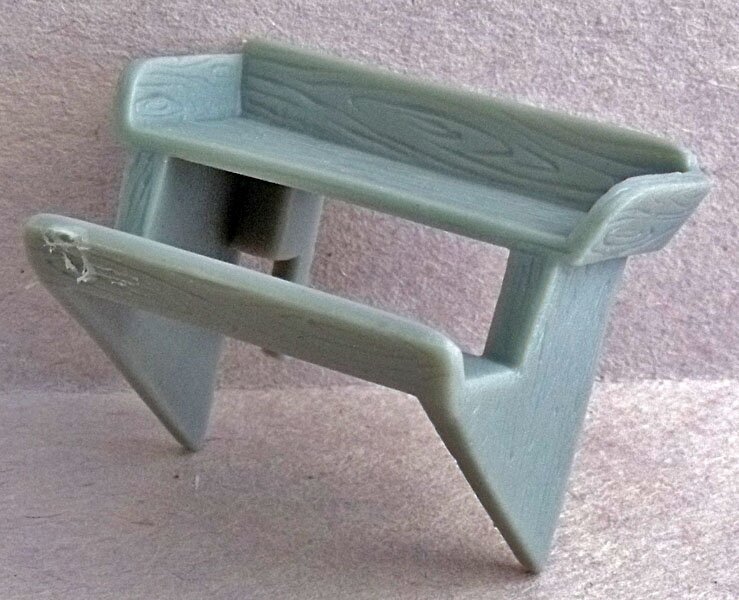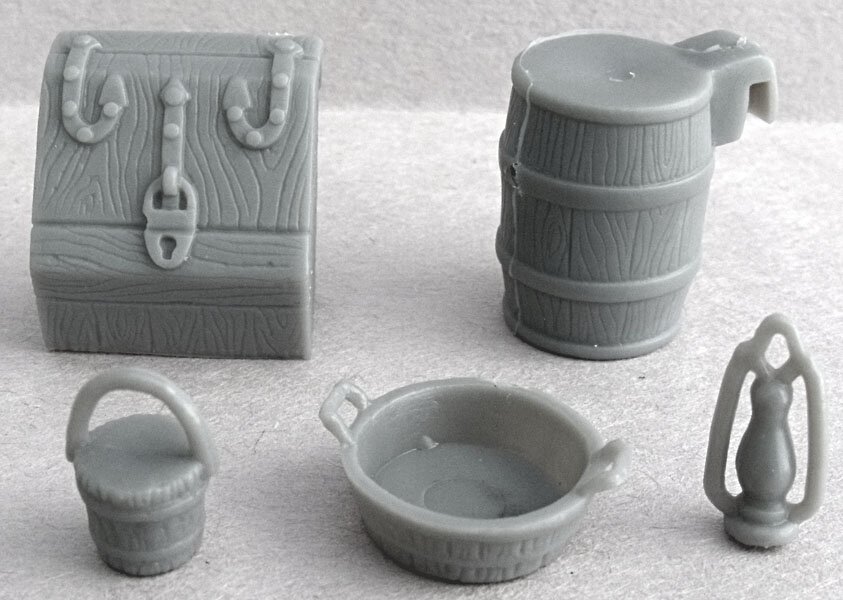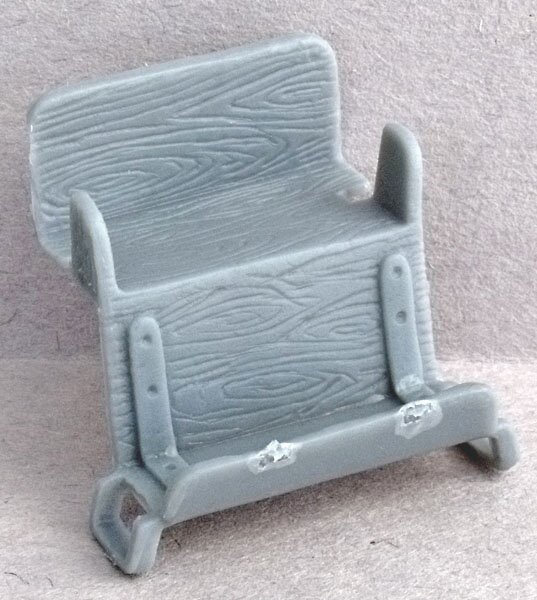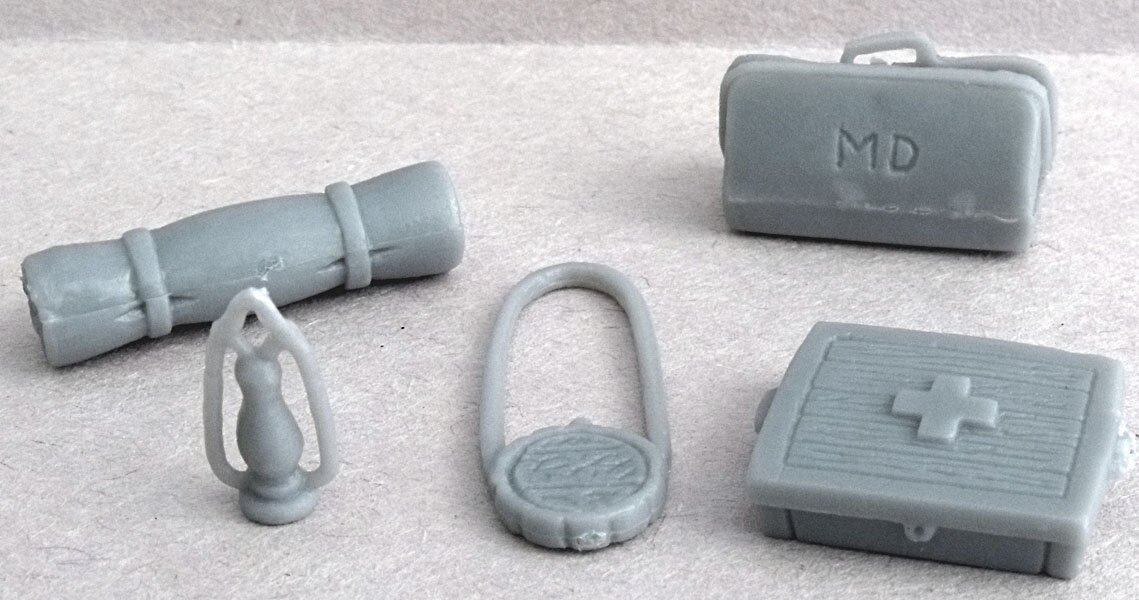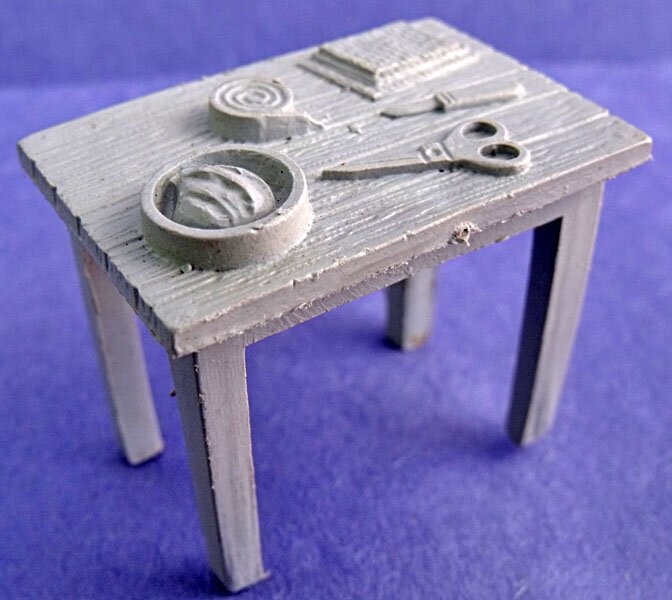|
An Inventory of Civil War Playset Figures, Structures and
Accessories Manufactured by the Marx Toy Company, 1951 to 1980
Appendix C, Page 3 - Playset Accessories
|
Contents of this web site may not be reproduced or duplicated for use on the Internet or for commercial purposes without permission by Eric Johns.
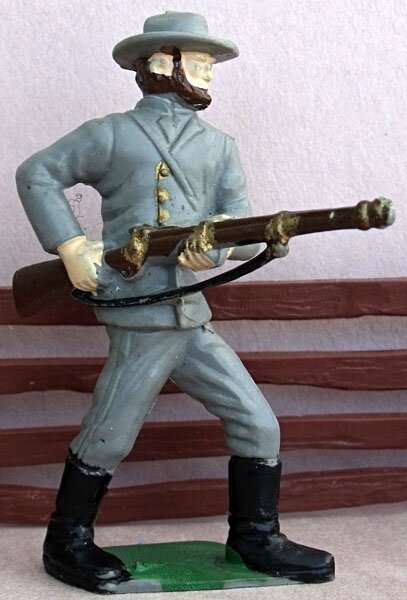 Table of Contents
(click on name to move to section)
|
| This Page |
| Structures and terrain pieces |
| Battlefield accessories |
| Cannon and wagons |
| Other Pages |
| Page 1 - Civil War Playset Figures |
| Page 2 - Civil War Other Playset-related Figures |
| Page 4 - Civil War Playset List |
| Back to the Civil War Table of Contents |
| Back to the Main Table of Contents |
Structures and terrain pieces
Buildings
Southern Mansion
PL-930 (porch or portico for tin litho mansion)
As most Marx playsets, the Civil War sets included a tin litho building, this one representing a Southern mansion. Looking very much like Louis Marx' own house in New York, the building was the "big house" on a Soutern plantation. In reality the building was very much undersized, made with the same piece that produced down-sized Wild West cabins, with fresh lithography. Two brick chimneys and a white plastic portico that snapped onto the building gave it the necessary formal look of an old plantation house.
The mansion came in three versions. The photo below is of the second version, which appeared in playsets manufactured in 1961. Prior to that, the mansion was the same, except it did not have the year 1861 printed over the doorway. In the Heritage Civil War Playset of 1972, the building is made with a "satin" finish rather than the glossy finish over the first two versions.
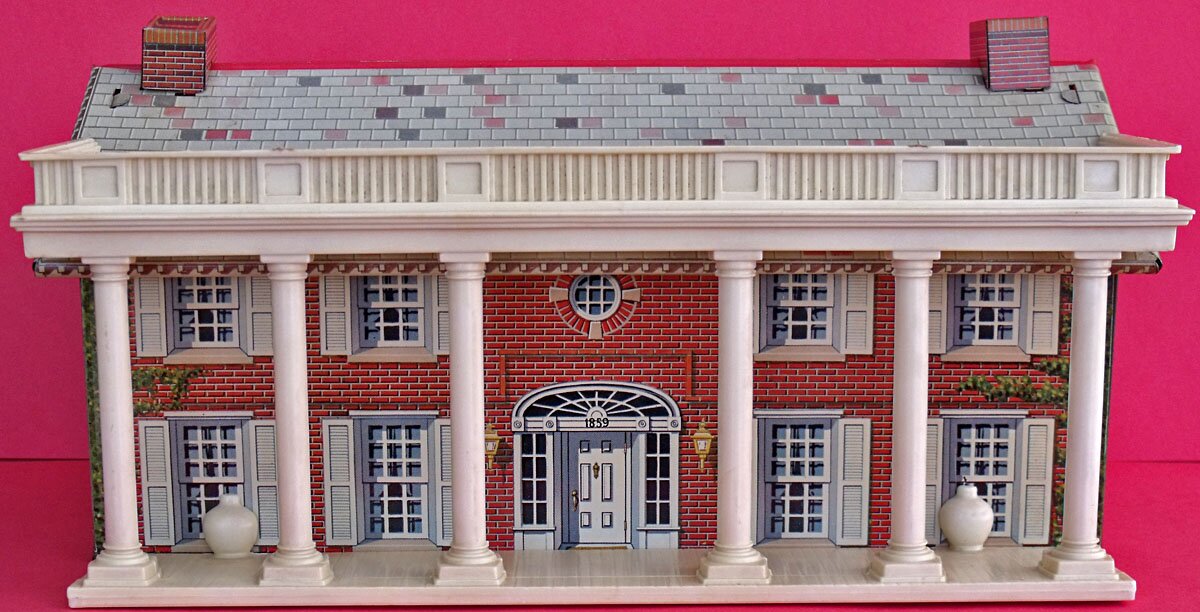 |
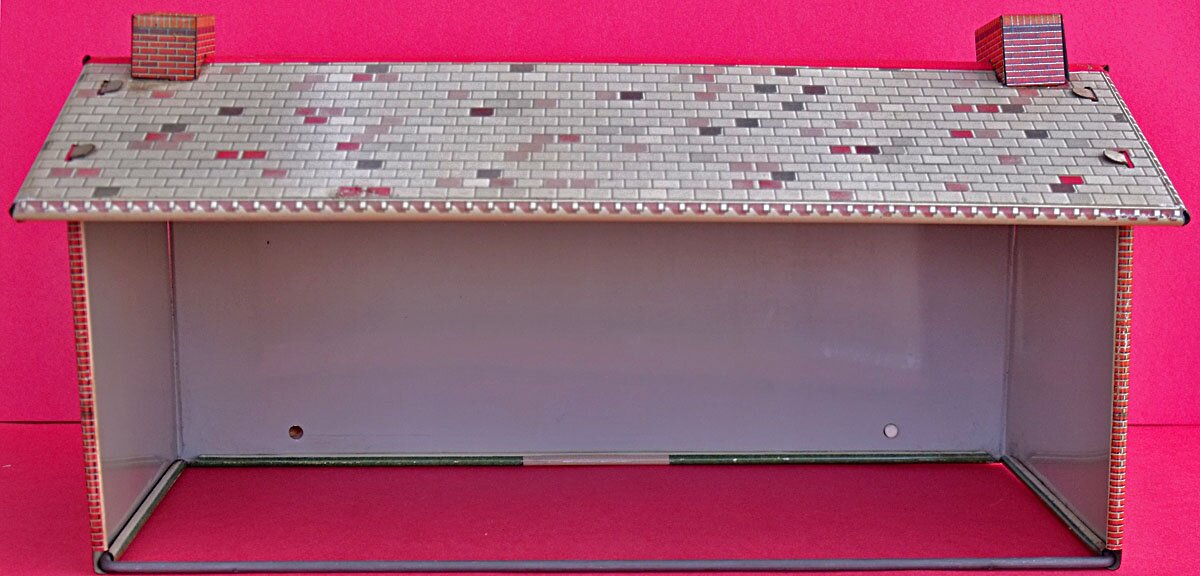 |
| Southern Mansion - front view | Southern Mansion - back view |
| Recent Price Line | ||||
| Mansion | $45 | February 2011 | Ebay | |
Destroyed Mansion
PL-1091 (with redoubt shown below)
In later playsets, a plastic representation of a destroyed mansion was added to the Civil War accessories. It debuted with the Giant Blue and Gray set in 1961. The piece is an attractive piece made of brown, often-marbled hard plastic, and measures 6-1/4 inches wide, 3-3/4 inches tall, and about 3 inches deep.
This mansion is much closer to 54mm scale than the tin litho mansion, but unfortunately is only a small piece of the much larger mansion it originally would have been. It is still a nice backdrop for either Union or Rebel troops.
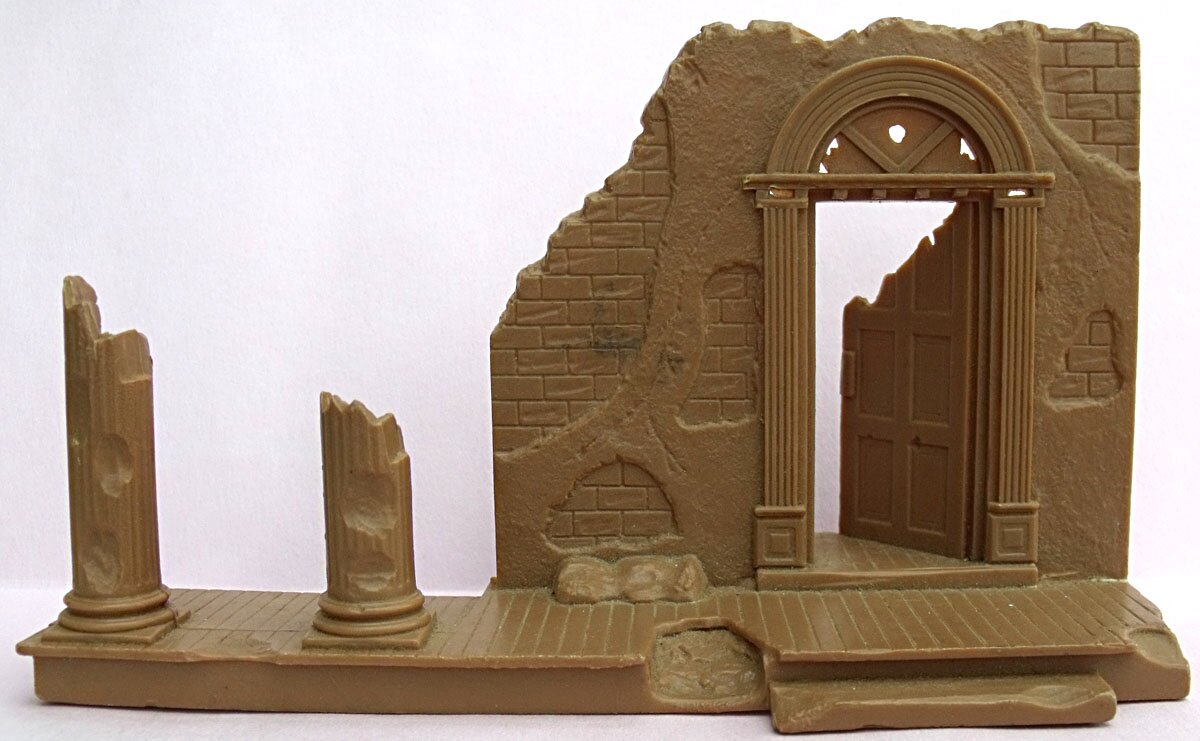 |
| Destroyed mansion |
Tents
PL-765
Playsets came with two types of tents: large command tents and small pup tents. Most sets had one mold group made up of one large and three small tents, as well as a cot that came from the same mold. The cot, slightly undersized, was a 2-piece, snap-together item divided into a top and legs. These items were most often in tan, and sometimes gray.
Note the tab on the side of the large tent in the photo below. There is also one on the other side and one in the back. These seem to serve no purpose and apparently were added only to 1) help Marx remove the large tent from the mold or 2) according to collector Josh Petrie, allow the tent to be glued down in store displays.
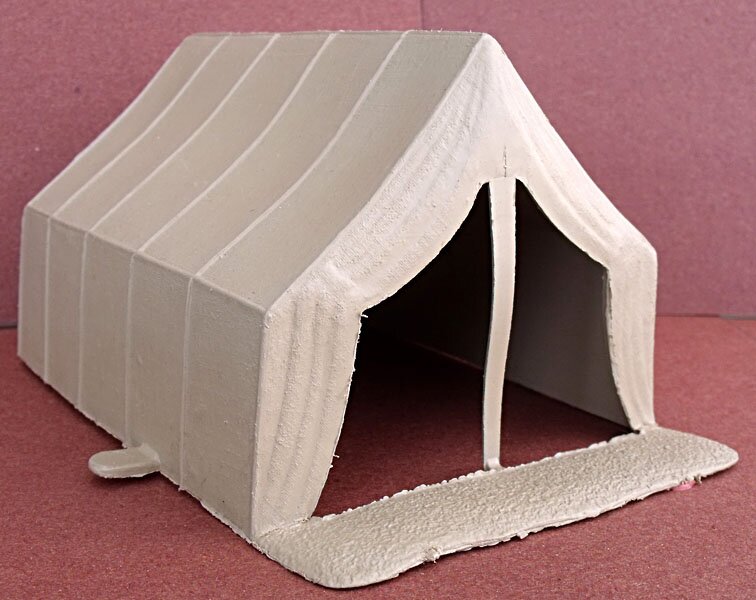 |
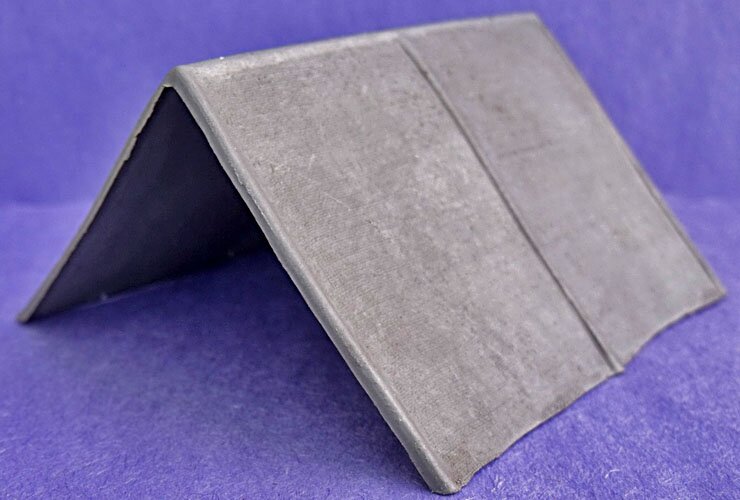 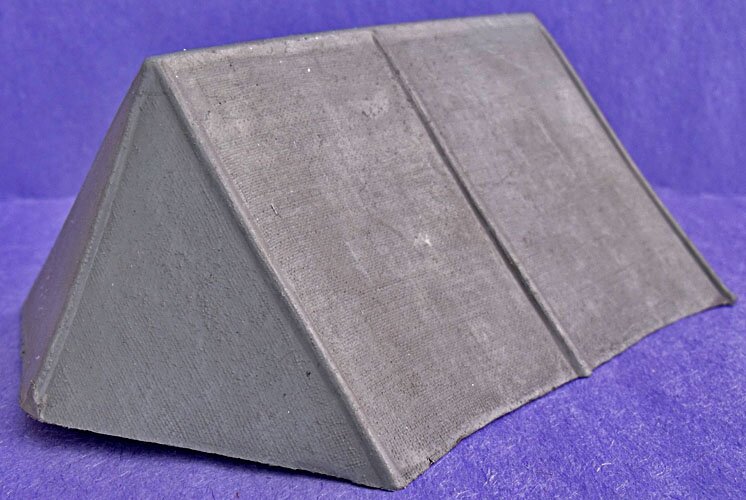 |
| Headquarters tent | Pup tent (front and back views) |
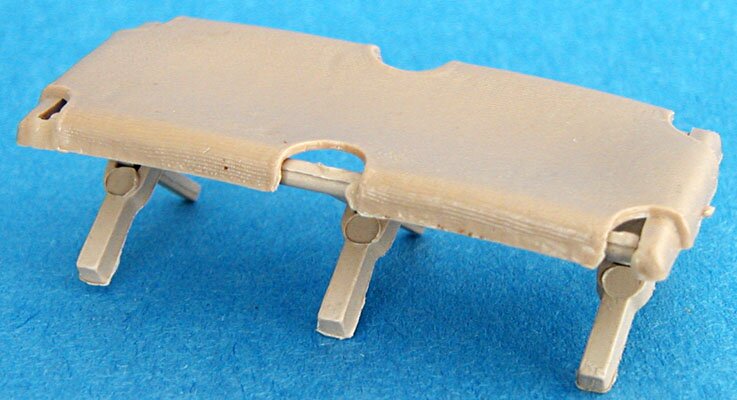 |
|
| Cot |
Trees
PL-524 "A" tree
PL-332 and PL-332A Dead tree and stumps
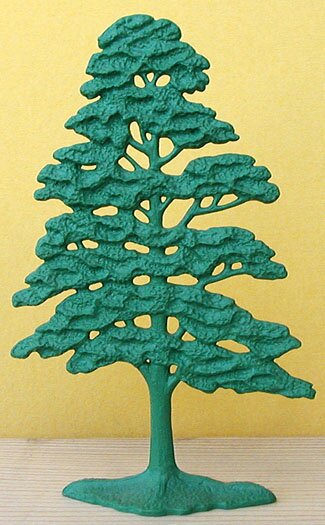 |
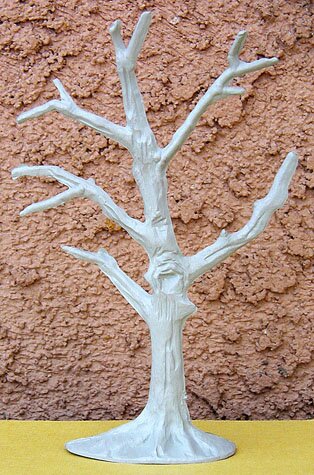 |
| "A" style tree | Dead tree |
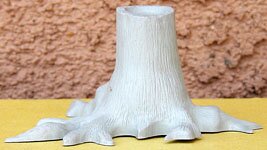 |
 |
| Large stump | Small stump |
Rocks
PL-944 (with bridge shown below)
Two rock piles were included in some Civil War sets, made in the same mold that produced the bridge shown later on this page. The rocks came in the same light gray hard plastic as the bridge.
Bulge center is about 2-1/4 inches wide at its widest point and 2 inches deep. Bulge left is 2-1/2 inches wide and 1-7/8 inch deep. The names for these rock piles were coined by Tim Geppert in a PFPC Issue 22 article on Marx rocks and trees.
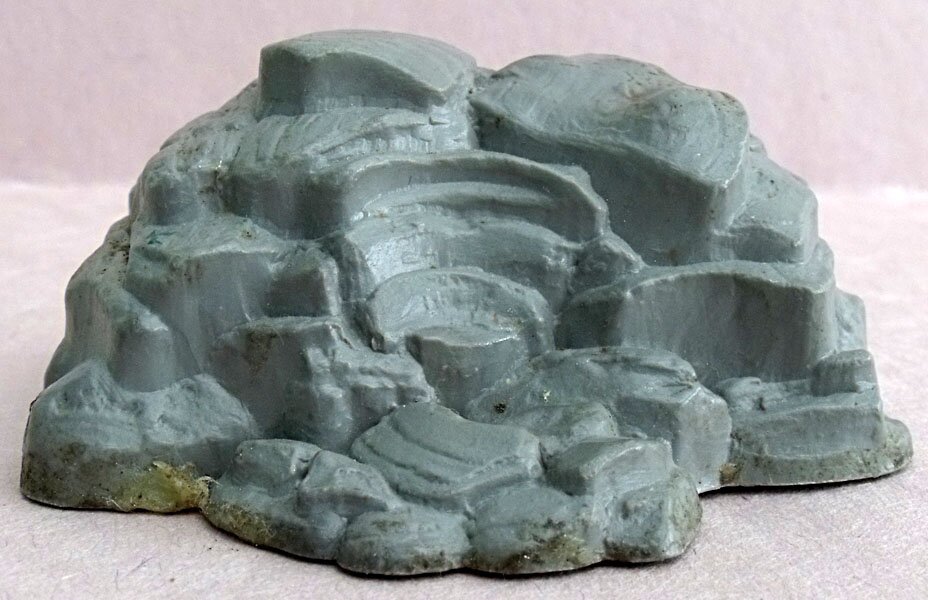 |
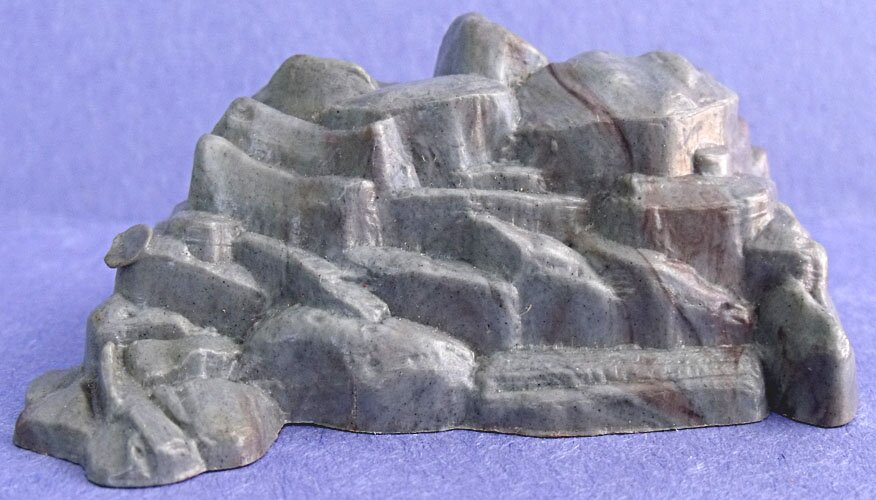 |
| Rock pile with a center bulge |
Rock pile with a left bulge |
In addition, the small Battle of the Blue and Gray playset #2646 included the "mesa rock" formation shown below, which normally was found in Wagon Train sets. The rock served as a humble centerpiece of the small set, as it had no mansion, redoubt, or cassion. It measures 7-3/4 inches wide and 2 inches tall. Many of these rocks have a marbled plastic, such as the one below.
 |
|
Mesa Rock
|
Large battle pieces: Redoubt and bridge
PL-1091 (with destroyed mansion shown above)
Among the most impressive accessories in the Civil War sets are the hard plastic light brown redoubt and light gray bridge. For those of you unlearned in military jargon (like myself), a redoubt is a generally small, often temporary, enclosed defensive fortitication, usually an earthenwork and sometimes strengthened with bricks, wood, and similar materials.
Marx documentation refers to the item as a "trench system," and it may have been originally envisioned as such. But once cost was considered, the item became a very attractive light brown, hard plastic piece that depicts a mostly dirt mound supported by a wooden framework, with a depression in the middle to allow cannon fire. Sand bags, a wagon wheel, a barrel, and part of a wooden box can be seen in the mound, as well as two depressions that appear to be the result of enemy fire.
The redoubt is about 8 inches wide, 5 inches deep, and 2 inches high. In the 1972 Heritage playset, it came in dark brown. In fact, the Heritage set included two redoubts, but it had no destroyed mansion. The redoubt has been re-issued, including a slightly large version that has two cannon locations.
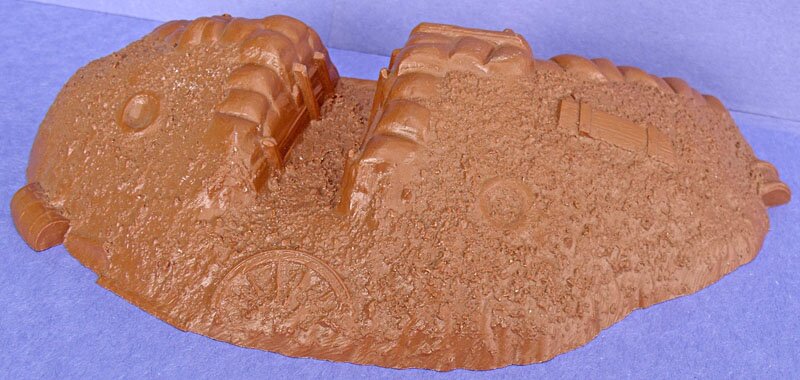 |
| Redoubt - front view as seen by attacking soldiers |
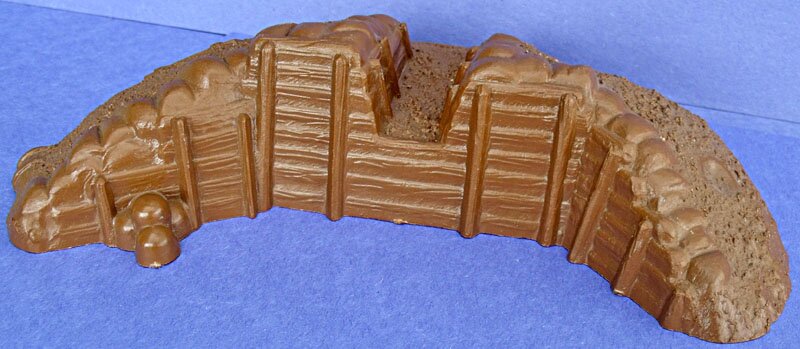 |
| Redoubt - inside view as seen by defending soldiers |
Burnside Bridge
PL-944 (with rock piles shown above)
The battle-damaged arched bridge is in light gray hard plastic. It is about 10 inches long, 4-1/2 inches wide, and 2-1/2 inches tall at its highest point. The bridge fits nicely across a river on playmats included in some Civil War sets, with the center support sitting on an narrow island in the middle of the river.
The bridge is very similar to Burnside's Bridge (see photo) where Civil War soldiers clashed at Antietam, and collectors refer to it as the Burnside Bridge. Built in 1836, it crosses Antietam Creek and was a site of close and bloody fighting in the 1862 battle. U.S. soldiers took three hours to force their way across the bridge against the Confederates -- with thousands of men on
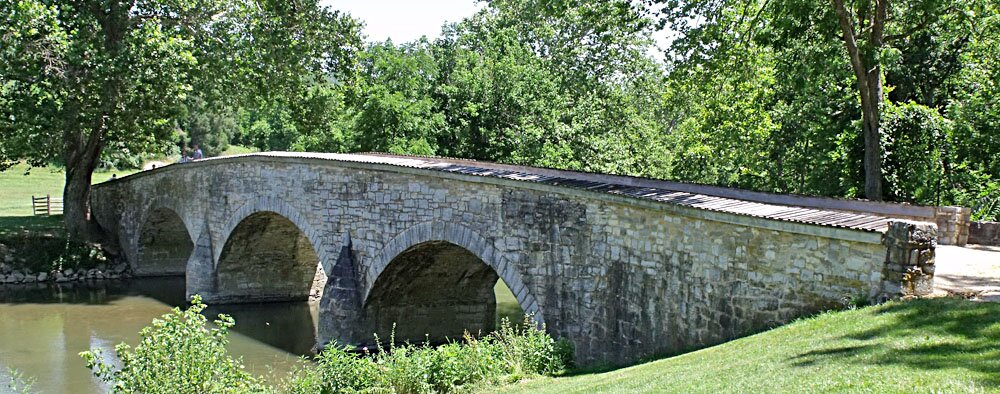 both sides -- eventually causing General Lee to order a night withdrawal in order to avoid further casulaties, ending the Confederate hopes to advance into Washington, D.C. Although the Marx version shows significant artillery damage, the actual conflict was an infantry struggle. The bridge was originally known as the Rohrbach Bridge, but troops at the battle simply referred to it as the lower bridge. It was later named Burnside in honor of General Ambrose Burnside, who commanded the U.S. soldiers there. The portion of the battle at the bridge involved thousands of men and resulted in many hundreds of casualties on both sides. The sycamore tree at the left side of the photo (which is bigger than in looks in the photo) reportedly has survived from the time of the battle.
both sides -- eventually causing General Lee to order a night withdrawal in order to avoid further casulaties, ending the Confederate hopes to advance into Washington, D.C. Although the Marx version shows significant artillery damage, the actual conflict was an infantry struggle. The bridge was originally known as the Rohrbach Bridge, but troops at the battle simply referred to it as the lower bridge. It was later named Burnside in honor of General Ambrose Burnside, who commanded the U.S. soldiers there. The portion of the battle at the bridge involved thousands of men and resulted in many hundreds of casualties on both sides. The sycamore tree at the left side of the photo (which is bigger than in looks in the photo) reportedly has survived from the time of the battle.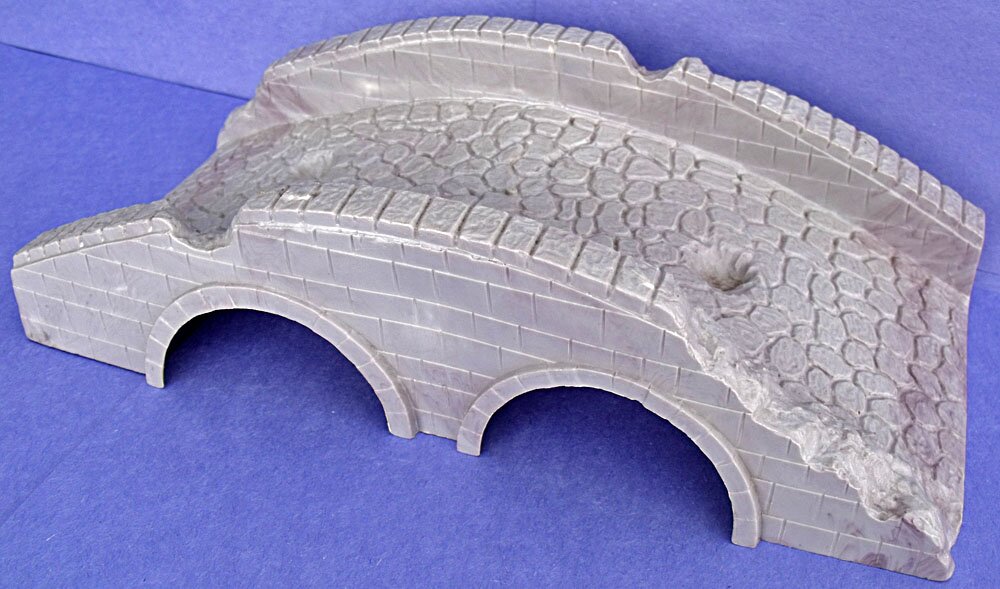 |
| Burnside's bridge - view from one side |
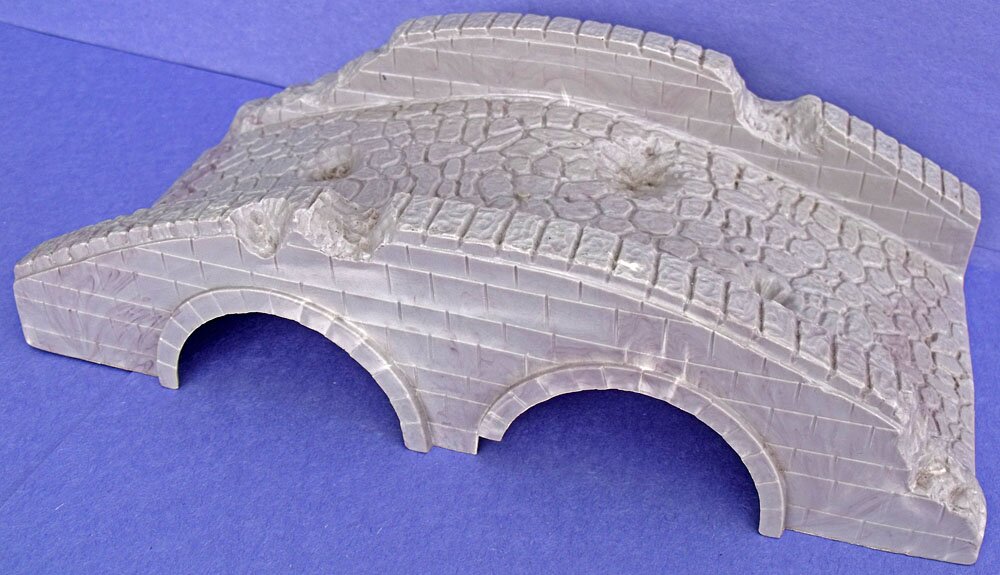 |
| Burnside's bridge - view from the other side |
Exploding bunker
PL-1056
The exploding bunker -- also used in several World War II playsets -- was a popular item that was added to a few later Civil War sets, beginning with the Giant Blue and Gray set in 1961. As shown below, the item came in several pieces, along with a small metal target that fit into the side of the bunker. When the target was hit, the bunker pieces flew apart, scattering any troops that happened to be taking refuge in it. The exploding bunker certainly added a lot of "playability" for kids in the 1960s. Collectors love it, but partially due to its intended use, original exploding bunkers are hard to find today.
Non-working re-issues are available.
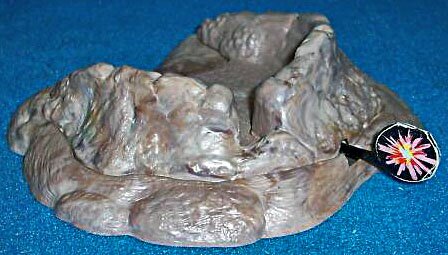 |
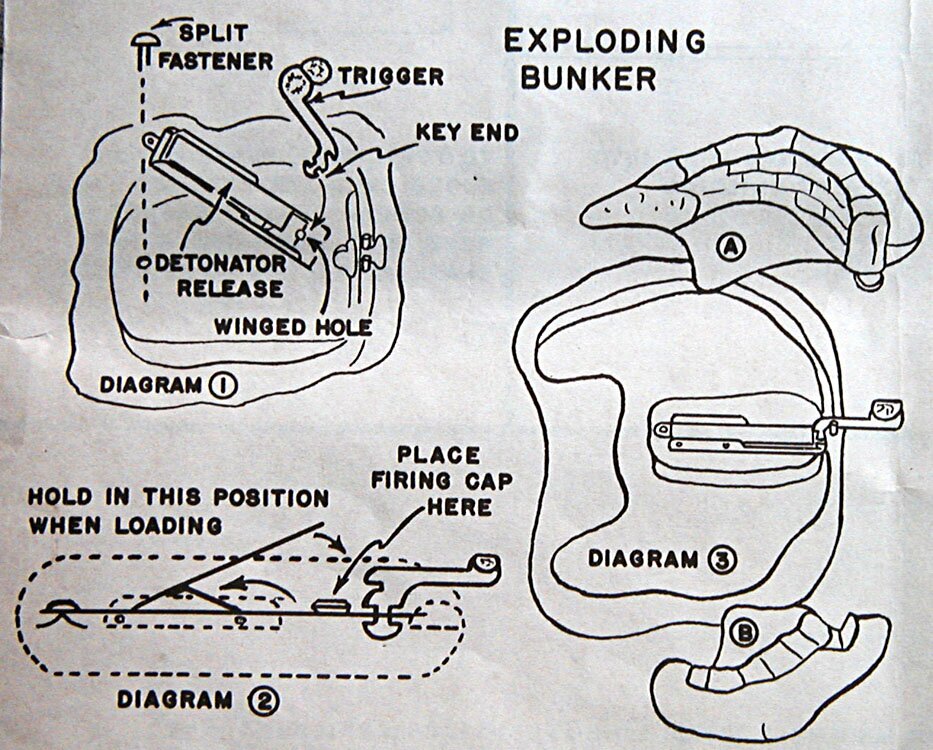 |
| Exploding bunker Photo courtesy of Jim McGough, Ebay j.mcgough |
Playset drawing on assembly of exploding bunker |
 |
|
| Pieces of exploding bunker Photo courtesy of Jim McGough, Ebay j.mcgough |
| Recent Price Line | ||||
| Complete bunker in working condition | $155 | March 2011 | Ebay | |
Civil War fence
PL-1092
Marx created a new type of fence for its Civil War sets, making fence pieces that could be placed in the straight winding pattern seen in so many Civil War photos. These soft plastic fence pieces came in two styles, one in good condition and one with the top two rails broken. The pieces could not stand alone; the ends of each piece were threaded into the ends of the adjacent piece. This provided a very realistic fence, but the company included only a few pieces in each set, usually one of the broken pieces and two or three of the unbroken. Most came in gray, but brown was occasionally used.
 |
| Fence - in light gray |
 |
| Broken fence - in brown |
Flags, poles, and bases
PL-
All Civil War sets included two flags, a 36-star U.S. flag and a Confederate flag. As most Marx flags, these were made of lithographed tin with two rounded tabs to hook onto flag poles.
The flags used the second version of Marx' flag poles, which was squared off with four sides. The peg at the bottom of the pole fits into a base resembling a mound of dirt. These same flags (with various lithography), poles, and bases were used in many other Marx playsets.
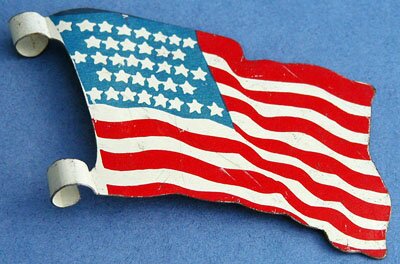 |
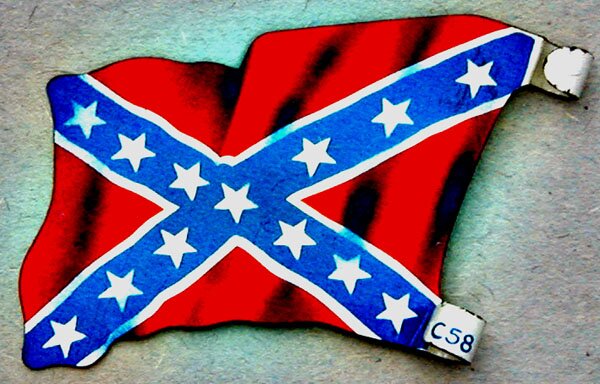 |
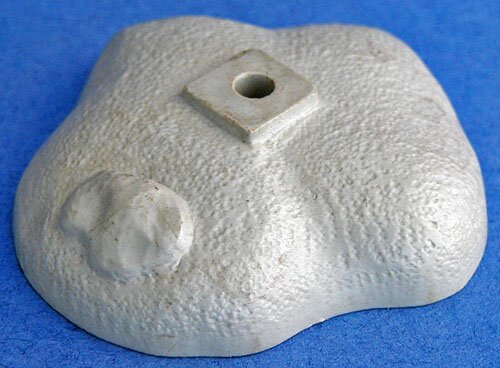 |
| U.S. 36-star Flag (tin litho) |
Rebel Flag (tin litho) |
Flag pole base |
 |
||
| Flag pole | ||
Go to top of page
Battlefield accessories
24-piece Accessory Set
PL-909A and PL-909B
This accessory set was made specifically for the company's Civil War playsets. The 24 pieces made up 22 items (3 were parts to a non-firing mortar), with 5 of these 22 being duplicates. So there were 17 different items. The accessories came in gray and tan, plus dark brown from the 1972 Heritage playset.
Although viewed as one group of accessories, the pieces were made in two molds, PL-909A and PL-909B.
Re-issues exist, generally in dark brown, including colors that are very similar to original colors.
PL-909A
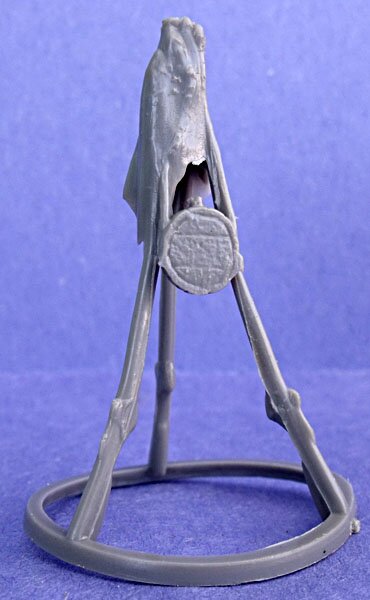 |
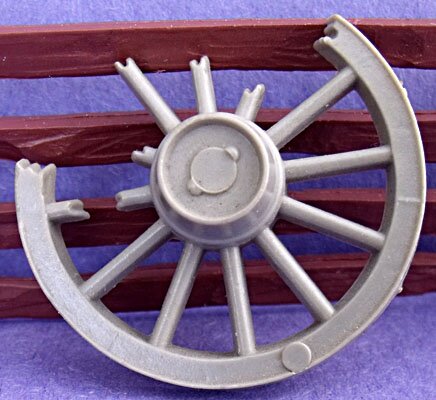 |
| 1. Rifle stack on circular base (2) |
2. Broken wheel (2) |
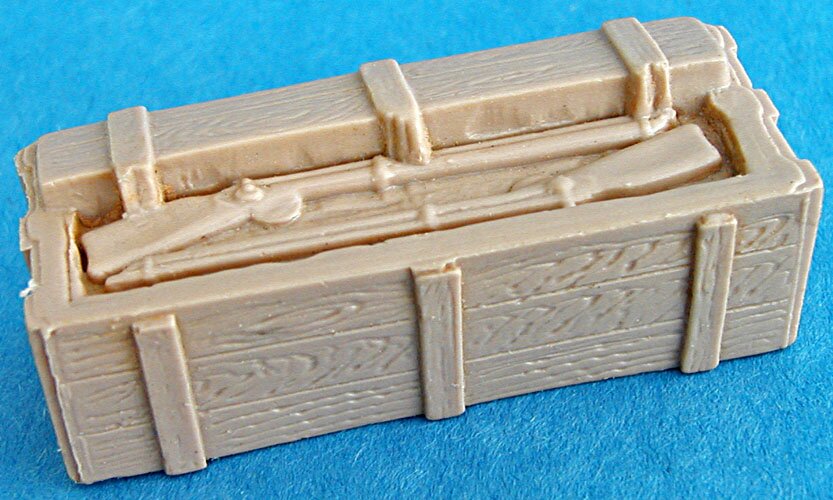 |
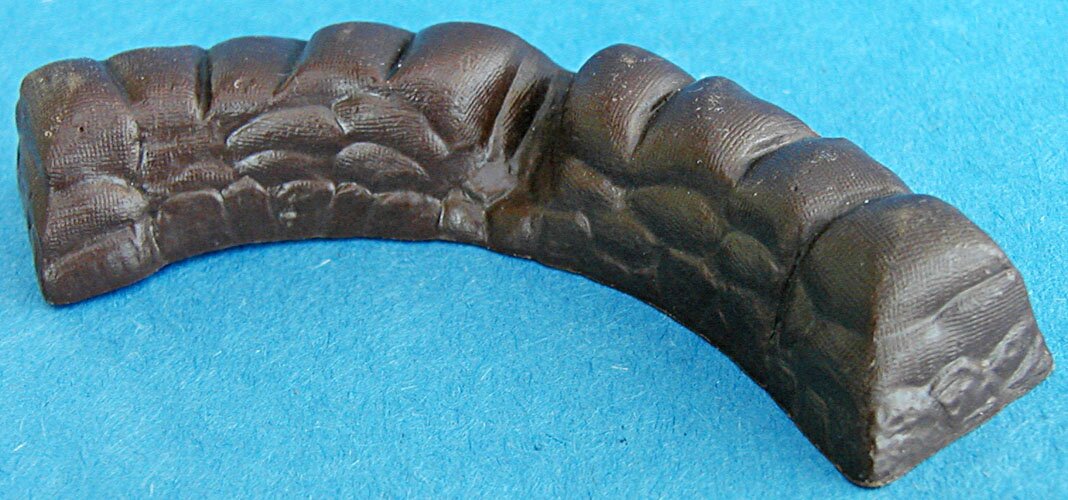 |
| 3. Crate of rifles | 4. Sandbag emplacement |
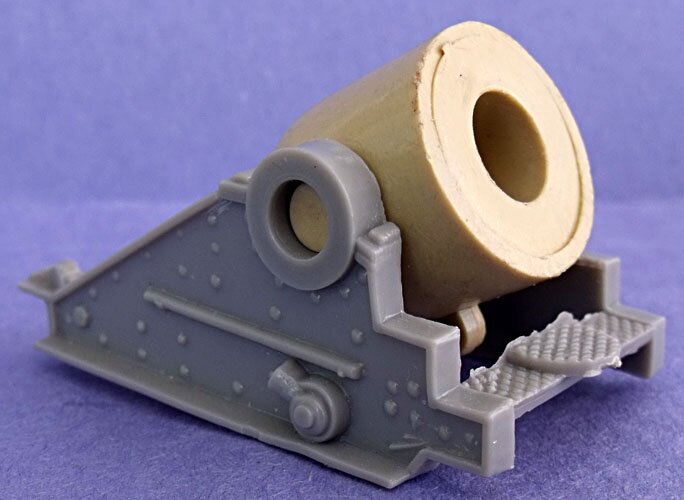 |
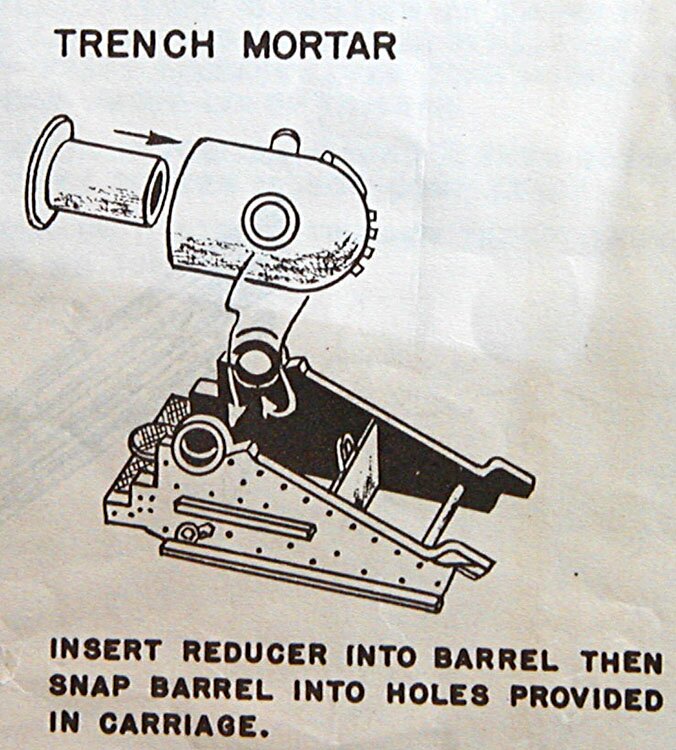 |
| 5. Non-firing mortar Core of barrel is from PL-909B and is shown below. |
Playset instructions to assemble 3-piece mortar |
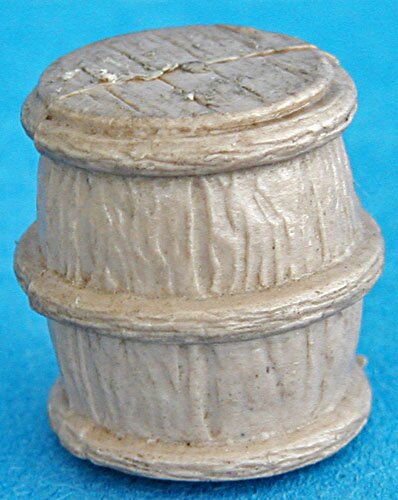 |
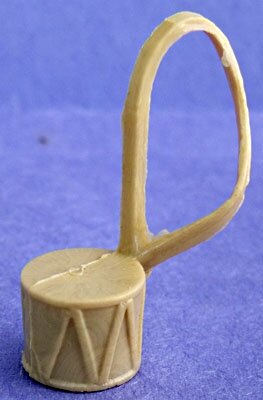 |
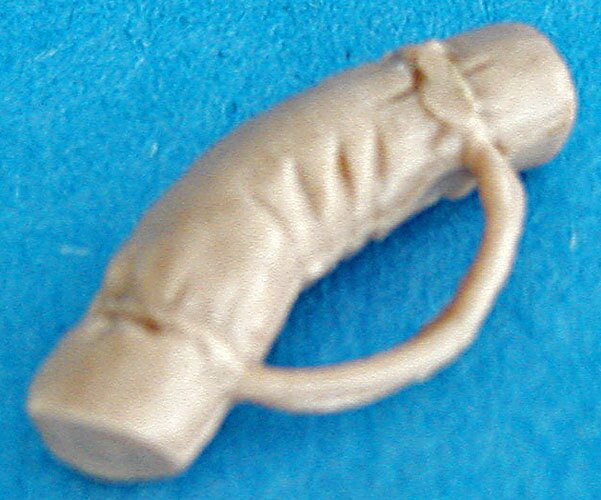 |
| 6. Barrel | 7. Drum with strap | 8. Bedroll with strap |
PL-909B
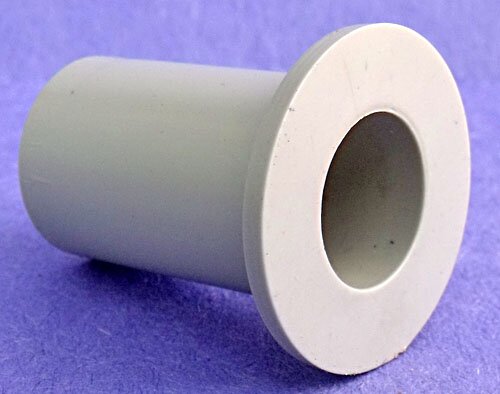 |
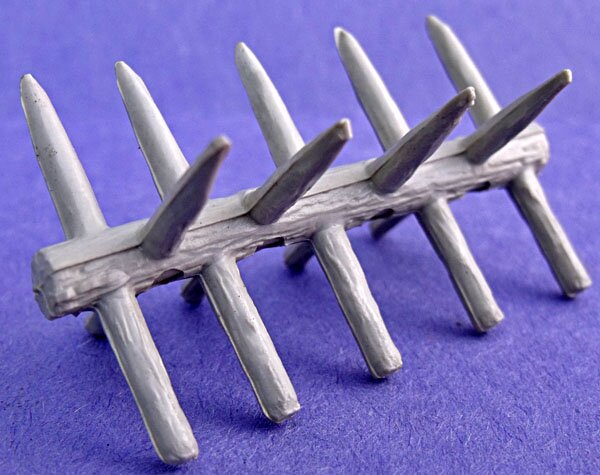 |
| 1. Inside of mortar barrel (see Item 5 in PL-909A above) |
2. Spiked barricade (2) |
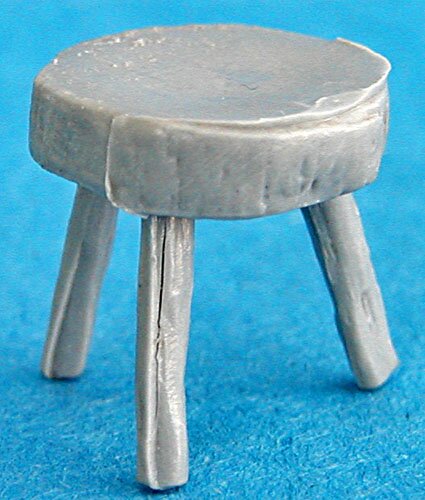 |
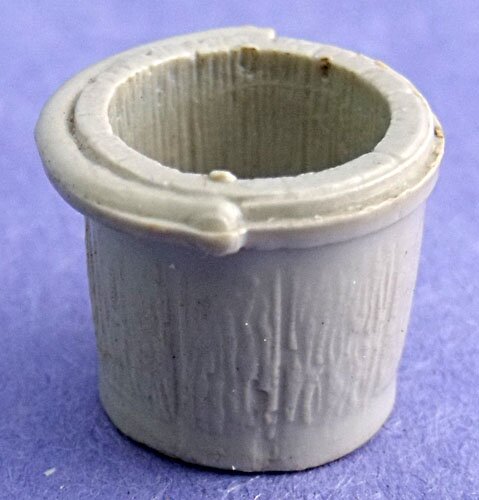 |
| 3. 3-legged stool (3) | 4. Bucket (2) |
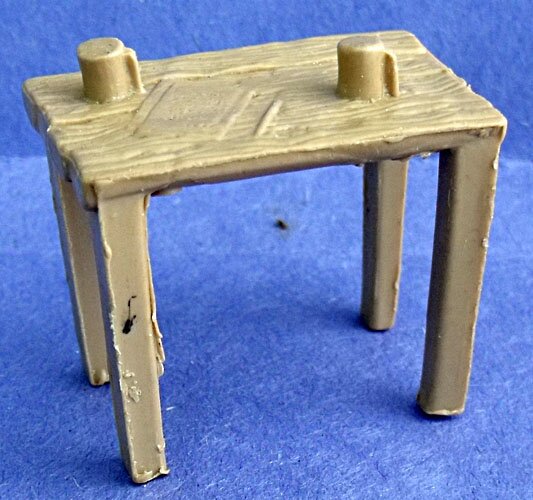 |
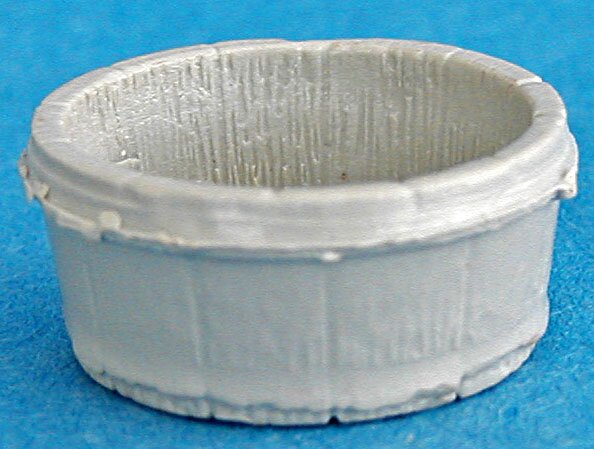 |
| 5. Dispatch table |
6. Wash basin |
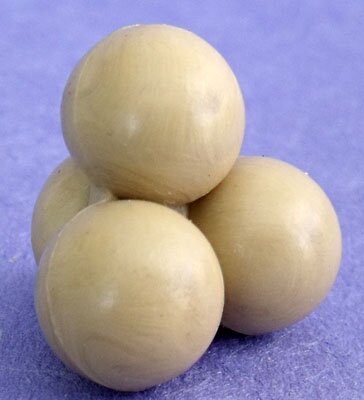 |
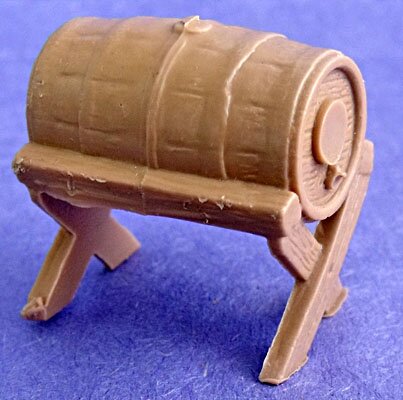 |
| 7. Pile of cannon balls | 8. Keg on stand |
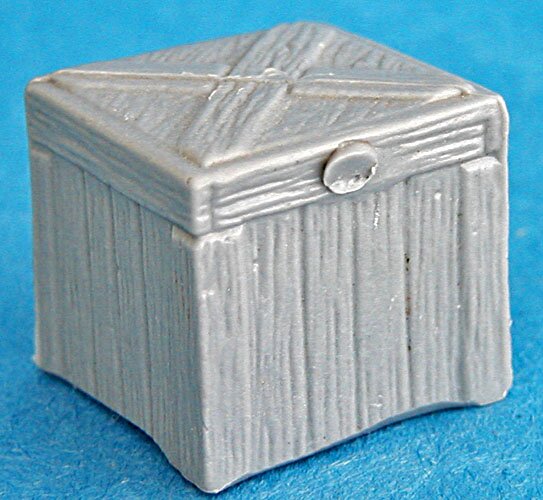 |
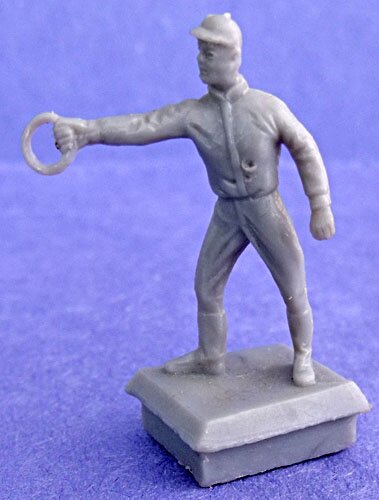 |
| 9. Wooden box | 10. Lawn jockey |
Small Accessories Sprue
PL-908
One marketing ploy used by Marx was to create small playset items that would increase the number of pieces included in a playset. Supposedly, "piece count" was an important consideration among us kids (or perhaps our parents) in deciding which playset to purchase back in the 1950s and 1960s.
The mother of all small playset items made by Marx was the "small accessory sprue." A sprue is simply a generally-round strip of plastic to which are attached various playset items, such as figures and accessories. These small accessory sprues hold very small items that are related to the intended playset theme. For example for Civil War sets, Marx created a sprue with 35 pieces (including 16 different items) such as swords, rifles, pots and pans, campfires, and other such things that one might expect to see around Civil War battlefields and camps. The Civil War sprue was also used for U.S. Cavalrymen in playsets of Old West themes, so today collectors variously refer to it as the Civil War or Cavalry accessory sprue.
To read and see more about these accessory sprues, get a look at an article written by veteran collector Tim Geppert that is in PFPC Issue 25. The article details all seven sprues that Marx produced, with photos of each one. Other than the Civil War/Cavalry sprue, these were for cowboys, Indians, GIs, farms, service stations, and doll houses. Marx never made a small accessory sprue for Revolutionary War sets (see the Revolutionary War introduction page for more on this mistake).
These sprues were generally soft plastic -- they have been re-issued in hard plastic -- and were made in various colors, including black, silver, red, and yellow. A rare red brown sprue will occasionally be found, but very seldom. Sprues included in Civil War sets were black or silver.
One of the smallest of all Marx playset accessories is on the Civil War/Cavalry sprue -- the folded gloves. I measure the gloves at their widest points to be 3/8 of an inch wide, 1/4 of an inch high, and 3/8 of an inch deep. And even then, they are a bit oversized for the 54mm figures! If you drop them, you may never find them. Just what percentage of these do you think were swept up in the trash can, sucked into the vacuum bag, or swallowed by a pet within a week after us kids opened a new playset? They are not easy to find today, other than when still attached to an accessory sprue. On the other hand, I was able to purchase one very inexpensively, but then how many people are looking for these things? And once you obtain a pair and place them strategically in your toy soldier display, who will recognize what they are?
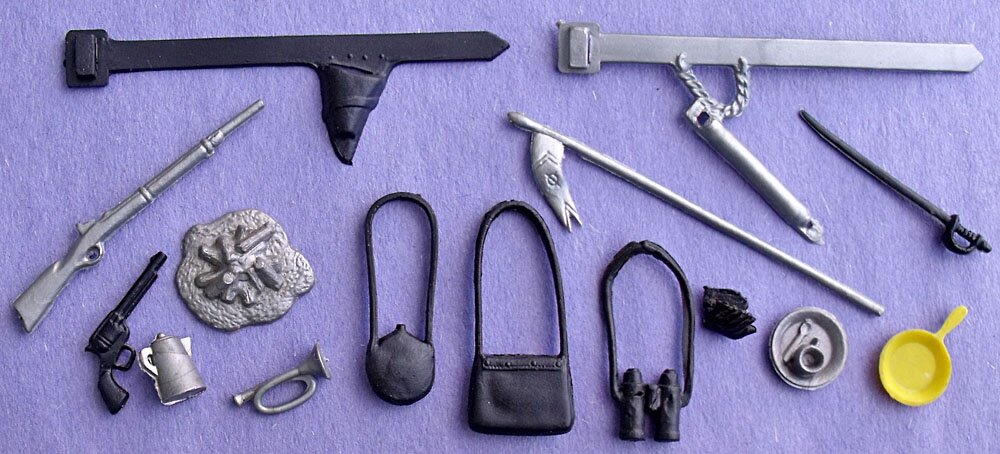 |
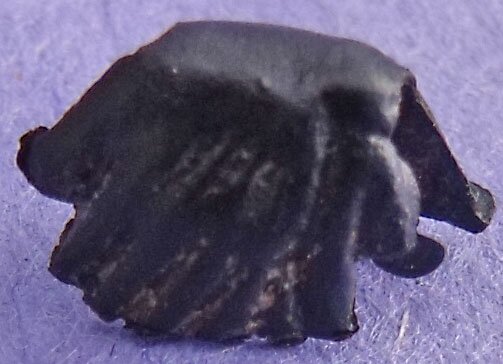 |
| Items from the Civil War small accessory sprue (missing wooden canteen) The yellow pan is identical to the pan on Civil War sprues, but is most likely from a cowboy sprue, because Civil War sprues were black or silver. |
The tiny folded gloves Yes, there are two thumbs, because there are two gloves! |
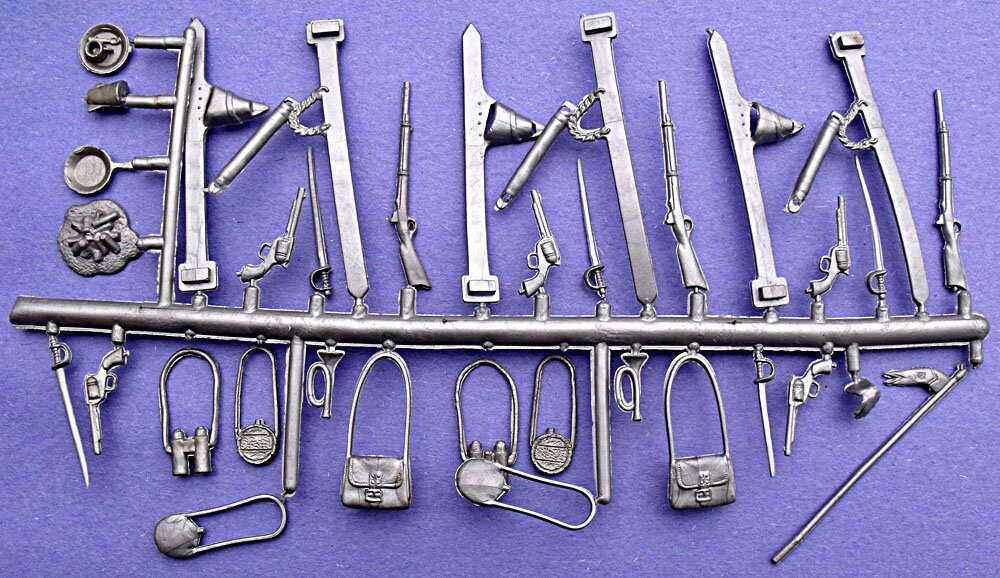 |
|
| Civil War Accessory Sprue Some items are no longer attached to the sprue, but are in the correct position as manufactured. Courtesy of collector Rob Colwell |
|
Go to top of page
